
Discover the top 10 historical sites for tourists in Lebanon, showcasing the country’s rich cultural heritage and history.
1. Beirut:
2. Byblos:
3. Baalbek:
4. Jeita Grotto:
5. Sidon:
6. Tyre:
7. Cedars of God:
8. Beiteddine Palace:
9. Harissa:
10. Qadisha Valley:
1. Beirut Lebanon:
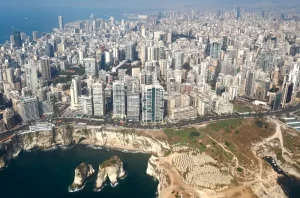
Beirut, the vibrant capital city of Lebanon, is a captivating blend of rich history, diverse culture, and modern sophistication.
Known as the “Paris of the Middle East,” Beirut is a bustling metropolis that offers visitors a unique and unforgettable experience.
The city is a melting pot of influences, with a mix of ancient ruins, stunning architecture, and a lively arts and culinary scene.
One of the highlights of Beirut is its stunning waterfront promenade, the Corniche, which, moreover, offers breathtaking views of the Mediterranean Sea.
It is a popular spot for locals and tourists to stroll, jog, or simply relax and enjoy the sea breeze.
The city is also home to a vibrant nightlife, with a plethora of trendy bars, clubs, and restaurants that cater to every taste and preference.
Beirut is steeped in history, with landmarks such as the iconic Pigeon Rocks, the National Museum of Beirut, and the historic district of Gemmayzeh.
These sites all offer a glimpse into the city’s rich past.
The city’s diverse cultural scene is also evident in its numerous art galleries, theaters, and music venues, showcasing the talents of local and international artists.
Despite its tumultuous past, Beirut has emerged as a resilient and dynamic city that continues to attract visitors from around the world.
Whether you’re exploring its ancient ruins, indulging in its world-class cuisine, or simply soaking up the vibrant atmosphere, Beirut is a city that never fails to impress.
It leaves a lasting impression on all who visit.
2. Byblos Lebanon:
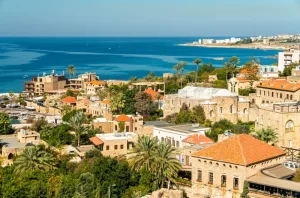
Byblos, also known as Jbeil, is one of the historical sites in Lebanon that holds a rich tapestry of culture, history, and natural beauty for tourists.
As one of the oldest continuously inhabited cities in the world, Byblos boasts a fascinating past that dates back over 7,000 years.
Its ancient ruins, including the iconic Phoenician temples, Roman amphitheater, and Crusader castle, offer a glimpse into the city’s storied history.
One of the most striking features of Byblos is its picturesque harbor, where colorful fishing boats bob gently in the crystal-clear waters of the Mediterranean Sea.
Visitors can stroll along the waterfront promenade, lined with charming cafes and restaurants serving fresh seafood and traditional Lebanese cuisine.
In addition to its historical sites, Byblos, Lebanon is also a center of artistic and cultural activities for tourists.
The city hosts an annual music festival that attracts renowned musicians from around the world, as well as art galleries showcasing the work of local and international artists.
Nature lovers will also find plenty to explore in Byblos, with nearby hiking trails offering stunning views of the surrounding mountains and valleys.
The city’s sandy beaches are perfect for sunbathing and swimming, making Byblos a popular destination for both history buffs and beachgoers alike.
Overall, Byblos is a must-visit destination for anyone looking to immerse themselves in Lebanon’s rich history, vibrant culture, and stunning natural landscapes.
Whether you’re wandering through ancient ruins or relaxing on the beach, Byblos offers a truly unforgettable experience for visitors of all interests.
One of the oldest continuously inhabited cities in the world, Byblos is a UNESCO World Heritage Site with a rich history dating back over 7,000 years.
3. Baalbek Lebanon:
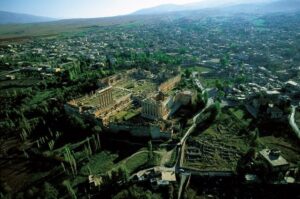
Baalbek, a city in Lebanon, is a historic city famous for its historical sites, ancient ruins, and rich cultural heritage that attracts tourists.
Some of the most well-preserved Roman ruins in the world are located in the city of Baalbek; in fact, they are a testament to the grandeur of ancient Roman architecture.
These ruins include the Temple of Bacchus, the Temple of Jupiter, and the Temple of Venus, showcasing the architectural prowess of the ancient Romans.
The Temple of Bacchus, dedicated to the Roman god of wine, is particularly noteworthy for its intricate carvings and massive columns.
It stands as a testament to the grandeur of Roman architecture.
The Temple of Jupiter, the largest Roman temple ever constructed, is another marvel that attracts visitors from around the globe.
Aside from its historical significance, Baalbek also offers a glimpse into Lebanon’s vibrant culture and traditions.
The city hosts various cultural events and festivals throughout the year, celebrating music, dance, and art.
Visitors can immerse themselves in the local culture by exploring the bustling markets, sampling traditional Lebanese cuisine, and interacting with friendly locals.
Moreover, Baalbek’s picturesque surroundings, with the snow-capped peaks of the Lebanon Mountains serving as a backdrop, add to the city’s charm.
The city’s serene atmosphere and stunning landscapes make it a popular destination for tourists seeking a blend of history, culture, and natural beauty.
In conclusion, Baalbek in Lebanon is a treasure trove of ancient wonders, cultural experiences, and breathtaking scenery, making it a must-visit destination for history enthusiasts and travelers alike.
4. Jeita Grotto Lebanon:
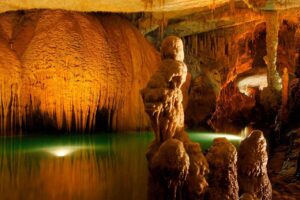
Jeita Grotto, located in Lebanon, is a natural wonder that captivates visitors with its stunning beauty and geological significance.
Jeita Grotto, renowned for its breathtaking stalactites and stalagmites, crystal-clear underground lakes, and awe-inspiring rock formations, comprises a series of interconnected limestone caves.
The grotto’s upper cave, accessible by a guided tour, features a mesmerizing collection of delicate formations; additionally, it showcases the intricate beauty of natural rock formations.
These formations have been sculpted over thousands of years by the slow drip of mineral-rich water.
Visitors can marvel at the intricate patterns and shapes created by nature, as well as the shimmering reflections in the still waters of the underground lake.
The lower cave, reached by a boat ride on the subterranean river, offers a unique perspective on the grotto’s geological wonders.
Towering rock formations and hidden chambers are waiting to be explored.
Jeita Grotto’s natural beauty is further enhanced by its lush surroundings, with verdant forests and scenic valleys providing a picturesque backdrop to the underground marvels.
The grotto’s serene atmosphere and cool temperatures offer a welcome respite from the heat of the Lebanese summer, making it a popular destination for both locals and tourists.
In addition to its natural splendor, Jeita Grotto also plays a vital role in scientific research, with geologists and biologists studying the unique ecosystem that thrives within its depths.
Overall, Jeita Grotto is a must-visit destination for nature lovers, adventure seekers, and anyone seeking to be awed by the wonders of the natural world.
5. Sidon Lebanon:
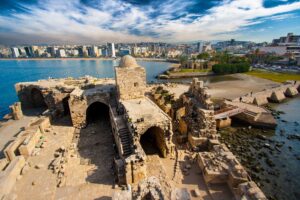
Sidon, located in Lebanon, is a historic coastal city that offers a blend of ancient ruins, vibrant culture, and picturesque landscapes.
As one of the oldest continuously inhabited cities in the world, Sidon, Lebanon, has a rich history.
This history of Lebanon is reflected in its archaeological and historical sites, as well as its architectural treasures for tourists.
The city is home to the impressive Sidon Sea Castle, a Crusader fortress perched on a rocky promontory overlooking the Mediterranean Sea.
Visitors can explore the castle’s well-preserved walls, towers, and dungeons while enjoying panoramic views of the sea and the city below.
In addition to its historical landmarks, Sidon is known for its bustling souks, where visitors can browse a variety of goods, from traditional handicrafts and textiles to fresh produce and spices.
The city’s vibrant markets offer a glimpse into daily life in Lebanon, with vendors hawking their wares and locals going about their daily routines.
Sidon’s culinary scene is also a highlight, with numerous restaurants serving up delicious Lebanese cuisine, including fresh seafood dishes that showcase the city’s coastal location.
Visitors can sample local specialties such as grilled fish, meze platters, and sweet pastries, all made with fresh, locally sourced ingredients.
Beyond its historical and culinary offerings, Sidon’s natural beauty is also a draw for visitors.
The city’s sandy beaches, clear blue waters, and lush greenery provide the perfect backdrop for relaxation and recreation.
Whether exploring ancient ruins, shopping in the souks, or simply soaking up the sun on the beach, Sidon offers a diverse range of experiences.
These experiences allow travelers to immerse themselves in Lebanon’s rich culture and history.
6. Tyre Lebanon:
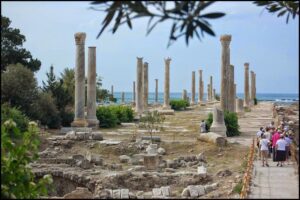
Tyre, a city in Lebanon, is famous for its history and culture, offering visitors a glimpse into its ancient past and vibrant present.
As a UNESCO World Heritage Site, Tyre is renowned for its well-preserved archaeological ruins.
These include the impressive Roman Hippodrome, which once hosted chariot races and other spectacles.
The city’s Roman-era ruins also include a sprawling necropolis, an ancient aqueduct, and a well-preserved Roman bath complex.
These sites provide insight into Tyre’s rich history as a major Phoenician city and later a Roman colony.
In addition to its archaeological treasures, Tyre is known for its picturesque seaside setting.
It features sandy beaches, clear blue waters, and a bustling harbor that serves as a hub for fishing and maritime activities.
Moreover, the harbor plays a crucial role in the local economy and culture.
Visitors can stroll along the city’s waterfront promenade, lined with cafes, restaurants, and shops, or relax on the beach and enjoy views of the Mediterranean Sea.
Tyre’s vibrant souks offer a taste of local life, with vendors selling everything from fresh produce and spices to handmade crafts and souvenirs.
Furthermore, these markets provide a unique opportunity to immerse oneself in the city’s culture.
The city’s culinary scene is also a highlight, with restaurants serving up traditional Lebanese dishes, including fresh seafood, meze platters, and sweet pastries.
Whether exploring ancient ruins, relaxing on the beach, or sampling local cuisine, visitors to Tyre are sure to be captivated by the city’s unique blend of history, culture, and natural beauty.
7. Cedars of God Lebanon:
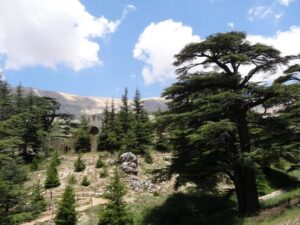
The Cedars of God is one of the historical sites, located in Lebanon, a magnificent forest of ancient cedar trees that has great cultural and historical significance and attracts tourists.
The Cedrus libani are some of the oldest trees in the world and are famous for their strength and resilience for hundreds of years.
The Cedars of God are often referred to in religious texts and ancient literature, symbolizing endurance, immortality, and the enduring spirit of Lebanon.
This UNESCO World Heritage Site is a must-visit destination for nature lovers, history enthusiasts, and spiritual seekers alike.
Walking among the ancient cedars, visitors can marvel at the sheer size and age of these magnificent trees, some of which are believed to be over a thousand years old.
The forest’s tranquil atmosphere and pristine natural beauty provide a peaceful retreat from the hustle and bustle of modern life.
This allows visitors to connect with nature and reflect on the passage of time.
In addition to its natural beauty, the Cedars of God also have historical significance, with some of the trees dating back to biblical times.
The forest has been a symbol of Lebanon’s national identity for centuries, appearing on the country’s flag and currency as a testament to its cultural importance.
Visitors to the Cedars of God can explore hiking trails, picnic areas, and scenic viewpoints.
By doing so, they immerse themselves in the timeless beauty of this ancient forest and gain a deeper appreciation for Lebanon’s natural heritage.
8. Beiteddine Palace Lebanon:
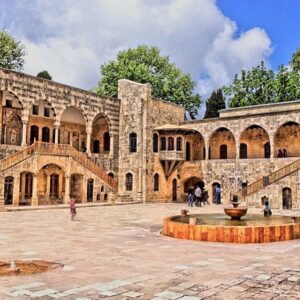
Beiteddine Palace, located in Lebanon, is a stunning example of Lebanese architecture and craftsmanship, showcasing the country’s rich cultural heritage and artistic traditions.
This magnificent palace, built in the 19th century by Emir Bashir Shihab II, is a masterpiece of Arabesque design.
It features intricate mosaics, ornate woodwork, and colorful frescoes that adorn its walls and ceilings.
The palace’s architecture blends elements of Ottoman, Persian, and European styles, creating a unique and harmonious aesthetic that reflects Lebanon’s diverse cultural influences.
Visitors to Beiteddine Palace can explore its beautifully preserved rooms, courtyards, and gardens, each offering a glimpse into the opulent lifestyle of Lebanon’s aristocracy during the Ottoman era.
The palace’s Grand Serail, or reception hall, is a highlight, with its soaring ceilings, marble columns, and stunning views of the surrounding mountains.
The palace also houses a museum that showcases a collection of artifacts, textiles, and artwork that provide insight into Lebanon’s history and culture.
In addition to its architectural splendor, Beiteddine Palace is surrounded by lush gardens and terraced courtyards, offering visitors a peaceful retreat from the hustle and bustle of modern life.
The palace’s location in the picturesque Chouf Mountains provides a scenic backdrop for exploring its grounds and enjoying panoramic views of the surrounding landscape.
Visitors to the palace can learn about Lebanon’s cultural heritage, admire the palace’s exquisite architecture, and stroll through its gardens.
9. Harissa Lebanon:
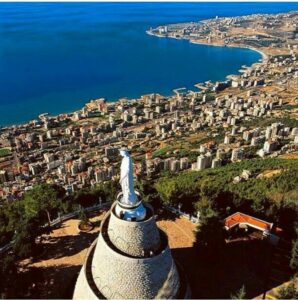
Harissa, located in Lebanon, is a charming hilltop village known for its breathtaking views, religious significance, and vibrant cultural heritage.
Perched high above the Mediterranean Sea, Harissa offers visitors panoramic vistas of the coastline and surrounding mountains.
This makes it a popular destination for tourists seeking stunning scenery and a peaceful retreat.
The Our Lady of Lebanon monument, which overlooks the ocean and serves as a symbol of peace and unity for Lebanon, is located in the town.
Pilgrims and visitors from around the world come to Harissa to pay their respects to the statue and enjoy the serene atmosphere of this sacred site.
In addition to its religious significance, Harissa is also a cultural hub, with charming streets lined with shops, cafes, and restaurants offering traditional Lebanese cuisine and handicrafts.
Visitors can explore the village’s narrow alleyways, visit local artisans, and sample delicious Lebanese dishes while taking in the picturesque surroundings.
The village’s rich history and warm hospitality make it a welcoming destination for travelers looking to immerse themselves in Lebanese culture and traditions.
Whether admiring the stunning views, exploring the religious sites, or savoring the local cuisine, visitors to Harissa are sure to be enchanted by the village’s beauty and charm.
With its unique blend of natural beauty, cultural heritage, and spiritual significance, Harissa is a must-visit destination for anyone seeking an unforgettable experience in Lebanon.
10. Qadisha Valley Lebanon:
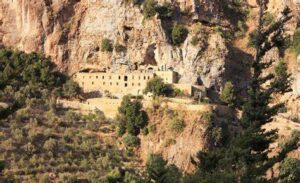
Qadisha Valley, located in Lebanon, is a breathtaking UNESCO World Heritage Site known for its stunning natural beauty, rich history, and spiritual significance.
The Qadishah Valley, located in Lebanon, is one of the historical sites and a UNESCO World Heritage Site for tourists.
It is known for its stunning natural beauty, rich history, and spiritual significance, attracting tourists.
This picturesque valley, also known as the Holy Valley, is home to ancient monasteries, hermitages, and churches carved into the rugged cliffsides.
These create a unique and awe-inspiring landscape that has captivated visitors for centuries.
The valley’s lush forests, winding rivers, and dramatic rock formations make it a haven for nature lovers, hikers, and photographers seeking to explore its pristine wilderness.
Qadisha Valley has long been a place of refuge for monks and hermits seeking solitude and spiritual contemplation.
Many of the valley’s monasteries date back to the early Christian era.
The valley’s monastic heritage is evident in the well-preserved frescoes, icons, and manuscripts found in its ancient churches and hermitages. These provide a glimpse into Lebanon’s rich religious history.
Visitors to Qadisha Valley can hike along scenic trails and visit historic monasteries such as the Monastery of Qozhaya and the Monastery of Saint Anthony of Qozhaya.
They can also marvel at the valley’s stunning vistas from viewpoints like the Balou Balaa waterfall.
The valley’s tranquil atmosphere, diverse flora and fauna, and cultural landmarks make it a must-visit destination.
It offers a unique and immersive experience in Lebanon’s natural and spiritual heritage.







